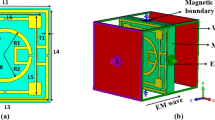Abstract
In this presented work, Split Ring Resonator (SRR) is arranged in 7X7X4 form to create a metamaterial superstrate which is incorporate on patch antenna. The SRR based metamaterial slab is analysed with Nicolson–Ross–Wier approach to extract the effective parameters of the medium. The Extracted parameters Shows that the relative permeability of the slab is near zero in the vicinity of the resonant frequency of the designed antenna. The experimental results clearly reflect that the gain of the superstrate loaded patch improves by 7.6 dB with variation less than 1 dB in the vicinity of resonant frequency. Structures are simulated on Ansoft HFSS v14 and experimentally verified.












Similar content being viewed by others
References
Balanis, C. A. (2016). Antenna theory analysis and design (3rd ed.). New York: Wiley.
Ziolkowski, R. W., & Kipple, A. (2003). Application of double negative metamaterials to increase the power radiated by electrically small antennas. IEEE Transactions on Antennas and Propagation, 51(10), 2626–2640.
Hao, Y., & Mittra, R. (2009). FDTD modeling of metamaterials: Theory and applications. Norwood: Artech House.
Engheta, N., & Ziolkowski, R. W. (2006). Metamaterials: Physics and engineering explorations. Hoboken: Wiley-IEEE Press.
Mendhe, S. E., & Kosta, Y. P. (2011). Metamaterial properties and applications. International Journal of Information Technology and Knowledge Management, 4(1), 85–89.
Jackson, D. R., & Alexopoulos, N. G. (1985). Gain enhancement methods for printed circuit antennas. IEEE Transactions on Antennas and Propagation, 33(9), 976–987.
Chung, K. L., & Mohan, A. S. (2004). Effect of superstrate thickness on the performance of broadband circularly polarised stacked patch antenna. IEEE Antennas and Propagation Society International Symposium, 1, 687–690.
Lee, D. H., et al. (2007). Design of novel thin frequency selective surface superstrates for dual-band directivity enhancement. IET Microwaves, Antennas and Propagation, 1, 248–254.
Euler, M., & Fusco, V. F. (2010). RCS control using cascaded circularly polarized frequency selective surfaces and an AMC structure as a switchable twist polarizer. Microwave and Optical Technology Letters, 52, 577–580.
Brito, D. B., et al. (2013). Metamaterial inspired Fabry–Pérot antenna with cascaded frequency selective surfaces. Microwave and Optical Technology Letters, 55, 981–985.
Gangwar, D., Das, S., Yadava, R. L., & Kanaujia, B. K. (2016). Circularly polarized inverted stacked high gain antenna with frequency selective surface. Microwave and Optical Technology Letters, 58(3), 732–740.
Attia, H., Yousefi, L., & Ramahi, O. M. (2010). Theoretical and experimental investigation of patch antennas loaded with engineered magnetic superstrates. In Wireless technology conference (EuWIT) (pp. 97–100).
Attia, H., Yousefi, L., & Ramahi, O. M. (2011). Analytical model for calculating the radiation field of microstrip antennas with artificial magnetic superstrates: Theory and experiment. IEEE Transactions on Antennas and Propagation, 59(5), 1438–1445.
Zhang, L., Contopanagos, H., Alexopoulos, N. G., & Yablonovitch, E. (1998). Cavity backed antennas with PBG-like substrate or superstrate materials. IEEE Antennas and Propagation Society International Symposium, 1, 186–189.
Zhang, L., Alexopoulos, N. G., & Yablonovitch, E. (1999). Microstrip line fed slot antenna with PBG superstrate. IEEE Antennas and Propagation Society International Symposium, 3, 1924–1927.
Attia, H., Siddiqui, O. F., Suwan, N., & Ramahi, O. M. (2013). Analytical and experimental study of gain enhancement in antenna arrays covered with high index metamaterial superstrate. Microwave and Optical Technology Letters, 55(1), 215–218.
Ju, J., Kim, D., Lee, W. J., & Choi, J. I. (2009). Wideband high‐gain antenna using metamaterial superstrate with the zero refractive index. Microwave and Optical Technology Letters, 51(8), 1973–1976.
Zhou, R., Zhang, H., & Xin, H. (2008). Experimental demonstration of narrow beam monopole antenna embedded in low effective index of refraction (n < 1) wire medium. Microwave and Optical Technology Letters, 50(9), 2341–2345.
Davor, B., Silvio, H., & Drazen, K. (2006). Experimental investigation of radiation properties of an antenna embedded in low permittivity thin-wire-based metamaterial. Microwave and Optical Technology Letters, 48(12), 2581–2586.
Zhou, R., Zhang, H., & Xin, H. (2010). Metallic wire array as low-effective index of refraction medium for directive antenna application. IEEE Transaction on Antennas and Propagation, 58(1), 79–87.
Wang, B., & Huang, K. M. (2010). Shaping the radiation pattern with MU and epsilon-near-zero metamaterials. Progress In Electromagnetics Research, 106, 107–119.
Gangwar, D., Juyal, P., Mittal, A., & De, A. (2011). Enhancement of front to back ratio and directivity with wire medium ε-Near zero metamaterial as superstrate in microstrip patch radiators. In Antenna Week (IAW) (pp. 1–4).
Ziolkowski, R. W. (2003). Design, fabrication, and testing of double negative metamaterials. IEEE Transactions on Antennas and Propagation, 51(7), 1516–1529.
Lee, D. H., & Park, W. S. (2009). Extraction of effective permittivity and permeability of periodic metamaterial cells. Microwave and Optical Technology Letters, 51(8), 1824–1830.
Basiry, R., Abiri, H., & Yahaghi, A. (2011). Electromagnatic performance analysis of omega type metamaterial radomes. International Journal of RF and Microwave Computer Aided Engineering, 21(6), 665–672.
Acknowledgements
We would like to thank Professor A. R. Harish, IIT Kanpur, India, for his permission to access antenna lab for measurement.
Author information
Authors and Affiliations
Corresponding author
Rights and permissions
About this article
Cite this article
Gangwar, D., Das, S. & Yadava, R.L. Gain Enhancement of Microstrip Patch Antenna Loaded with Split Ring Resonator Based Relative Permeability Near Zero as Superstrate. Wireless Pers Commun 96, 2389–2399 (2017). https://doi.org/10.1007/s11277-017-4303-3
Published:
Issue Date:
DOI: https://doi.org/10.1007/s11277-017-4303-3




